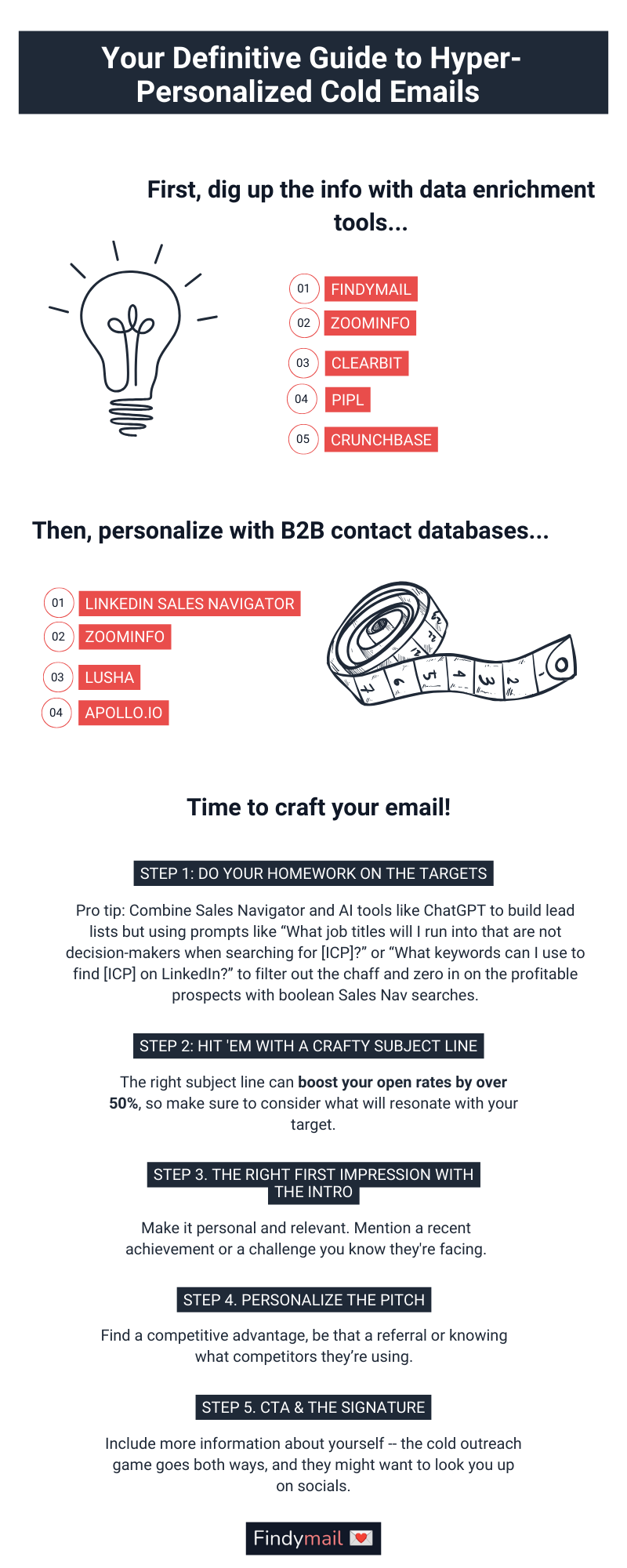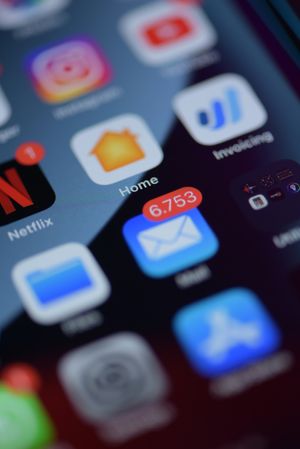You already know that personalized cold emails are a crucial part of your sales strategy.
But if you're chasing those big deals – the ones that make your heart skip a beat and your bank account smile – then listen up: you need to take your cold emails to the next level of personalization.
I’m talking hyper-personalization, buddy.
Forget generic templates and spray-and-pray tactics. In today's crowded and saturated inbox, you need to stand out to grab their attention and build those genuine connections.
And that's where hyper-personalization can help you win. Trust me, I've been there, done that, and I've learned a thing or two about what works and what doesn't.
So, buckle up and get ready to dive into the world of hyper-personalization. I'm here to be your guide, confidant, and mentor as we unleash the power of hyper-personalized cold emails so you can supercharge your sales game.
Let's do this!
Why Hyper-Personalization Matters
Before we jump into the nitty-gritty of crafting hyper-personalized cold emails, let's take a moment to understand why it's so damn important.
A well-crafted personalized email campaign has the potential to skyrocket your ROI. In fact, studies have shown that businesses that invest in personalization can expect a return of up to 122%.
But it doesn't stop there. Hyper-personalization can work wonders for your open rates and click rates too. Imagine this: by tailoring your cold emails to the individual recipient, you can boost your open rates by 29% and your click rates by 41%.
So, why does hyper-personalization pack such a powerful punch?
Well, think about it. In a sea of generic, one-size-fits-all emails, a message that speaks directly to your recipient's needs, pain points, and aspirations is like a breath of fresh air.
It shows that you've done your homework and that you genuinely care about solving their problems.
When you put in the effort to make your cold emails hyper-personalized, you're not just sending another pitch into the void. You're creating a connection, sparking interest, and increasing the likelihood of getting a response.
And that response can be the gateway to those big deals that will make all your hard work worthwhile.
Digging up the Info for Hyper-Personalized Emails
When it comes to hyper-personalization, data is your best friend. The more information you have about your prospects, the better you can tailor your cold emails to resonate with them.
But let's face it, gathering all that data manually can be a real pain in the you-know-where. That's where data enrichment tools and B2B contact databases come to the rescue.
Data Enrichment Tools
Think of data enrichment tools like private detectives that scour the web to gather valuable info about your leads. They fill in the gaps, providing you with a wealth of data that can be used for your hyper-personalization efforts.
And trust me, when you're dealing with hundreds or even thousands of entries in your lead lists, using these types of tools is a godsend.
Here are some top-notch data enrichment tools to consider:
- Findymail: Findymail specializes in email discovery, helping you find verified email addresses for your prospects so you can reach them directly.
- ZoomInfo: This powerhouse tool offers comprehensive data on companies, contacts, and industries, giving you the fuel you need to supercharge your hyper-personalization efforts.
- Clearbit: With Clearbit, you can enrich your leads with detailed firmographic and demographic data, helping you create highly targeted and personalized cold emails.
- Pipl: Pipl is your go-to tool for deep web searches, uncovering social media profiles, professional information, and contact details that can take your cold emails from good to extraordinary.
- Crunchbase: If you're looking to dive deep into the world of startups and high-growth companies, Crunchbase provides you with invaluable data, including funding rounds, key personnel, and industry trends.
The Best B2B Contact Databases for Email Personalization
Now, let's not forget about B2B contact databases.
These treasure troves of business information give you access to a wealth of potential leads, saving you time and effort in your search for the perfect recipients of your hyper-personalized cold emails.
Here are some notable B2B contact databases:
- LinkedIn Sales Navigator: With LinkedIn Sales Navigator, you can tap into the world's largest professional network, finding and connecting with decision-makers in your target industries. (Plus, if you integrate it with Findymail, it’ll scrape verified email addresses from Sales Nav for you – and addresses from LinkedIn post commenters, too.)
- ZoomInfo: As mentioned earlier, ZoomInfo not only offers data enrichment capabilities but also serves as a powerful B2B contact database, providing you with detailed profiles and contact information.
- Lusha: Lusha is another fantastic tool for finding accurate contact details, allowing you to reach out to the right people at the right companies.
- Apollo.io: Apollo.io focuses on connecting you with high-quality B2B contacts, ensuring that your cold emails land in the inboxes of decision-makers who can make a real impact on your business.
By leveraging these tools to your advantage, you'll be armed with the insights and contact information necessary to create hyper-personalized cold emails that hit the bullseye.
If you want to learn more about these tools (and some others) and how they work, I’ve already done a deep dive into data enrichment services and B2B contact databases, where I go into what you can expect from them and the best way to use them.
How to Craft Hyper-Personalized Cold Emails
Now let's get down to business and explore the steps you need to take in order to write a winning hyper-personalized email.

In my previous guide on cold emails, I covered the topic extensively, but here's a brief recap to refresh your memory:
Step 1: Do Your Homework on Targets
You need to have a solid understanding of your audience. Take the time to research their interests, pain points, and demographics (such as age, gender, location, role, and industry). Utilize data enrichment services and B2B contact databases to streamline this process and gather the necessary insights.
And here’s a pro tip I’ve been playing with recently.
You can combine Sales Navigator and AI tools like ChatGPT to build lead lists but using prompts like “What job titles will I run into that are not decision-makers when searching for [ICP]?” or “What keywords can I use to find [ICP] on LinkedIn?”
That way, you can really filter the chaff out and zero in on the wheat when using Boolean searches in Sales Nav.
Step 2: Hit 'em with a Crafty Subject Line
The subject line is super important because it determines whether your email gets opened or ignored. Spend time crafting a subject line that truly grabs attention.
The right subject line can boost your open rates by over 50%, so make sure to consider what will resonate with your target. Highlight their interests, goals, or a mutual connection.
Remember, the goal is to show them that this email is specifically tailored to them.
Step 3: You Need a Killer Introduction
Just like approaching someone you're interested in for a date, the introduction sets the tone for the conversation.
Make it personal and relevant.
Mention a recent achievement or a challenge you know they're facing. This demonstrates that you've done your homework, establishes a connection, and helps build rapport from the get-go.
Step 4: Personalize the Pitch
Take personalization a step further and tailor the entire message to your recipient. One effective approach is to use referrals.
For example, mention a mutual contact who recommended your product or service as the perfect solution for their specific challenge. Or, if you know they’re using a competitor, highlight how your offer is the better option.
Step 5: Round It Off with the CTA and Signature
Conclude your email with a clear and concise call-to-action (CTA) that compels the recipient to respond or set up a call. Don't forget to include your signature, which should include your name, contact information, and social media profiles.
Personalization works both ways, and they may want to learn more about you and your business.
7 Hyper-Personalized Cold Email Examples & Templates
OK, it’s time for the fun part! Let’s look at some examples and templates that demonstrate the power of hyper-personalization in cold emails.
1) Understanding Their Pain Points and Goals
When you dig deep and uncover their pain points or goals, it's like finding the secret sauce to crafting an email that hits home. You can relate to their struggles or aspirations and position yourself as the hero with the solution they've been yearning for.
So, when you're putting together your hyper-personalized email, talk about their goals or address their pain points.
Let them know you understand the hurdles they're facing or the dreams they're chasing.
This personal touch creates an emotional connection and makes your email super relevant and relatable. Trust me, when they see that you're speaking their language, they'll be more inclined to give you their attention and take action.
Template:
Subject: [[First Name]], [[Pain Point]] got you down?
Hey [[First Name]],
I noticed your post on Twitter that you’re looking to [[goal]]. As someone with experience, I know it’s frustrating when [[pain point]] gets in the way and holds you back.
That's why I wanted to introduce you to [[Your Product/Service]]. Our unique solution is designed to specifically address [[challenges]]. We've helped businesses just like yours overcome [[pain point]] and achieve remarkable results [[link to the case study/success story]].
I’d love to hop on a call to discuss how we can help you overcome these challenges and unlock new opportunities for growth. Are you free later this week for a quick 15-min chat?
If not, I can work around your schedule, so just let me know when it’s a good time for you.
2) Leverage Videos and Images
Why not add some visual pizzazz to your hyper-personalized cold emails? Trust me; it's a surefire way to really stick out in your prospect’s mind.
Videos are where it's at– they let you introduce yourself, show off your personality, and give a sneak peek into what your product can do.
And you don’t need to be a movie director or have a fancy setup to make this work. Tools like Vidu.io make it a cakewalk to create personalized videos to take your cold outreach to new heights.
So go ahead, get creative, and let those videos do the talking. It's a surefire way to grab attention and stand out from the crowd.
But if you're more of an image person, here's a clever trick from the book of Joe Speiser. All he does is snap a picture of himself holding a card with the prospect's name on it or their product:
Easy, right? But trust me; it works like magic. This personal touch shows you've gone the extra mile to make your email all about them.
It’s a simple but effective tactic that boosted his response rate from 1% to 10%, and he used this trick to bring in 50% MRR.
However, if you aren’t comfortable using your own face, you can use a site like Hyperise that lets you create custom personalized images like this:
3) Leverage Mutual Contacts
Don't be shy about using mutual connections you and the prospect have. It could be an old schoolmate, a previous client, or one of your social media friends.
Drop a name, mention how you're connected, and watch the magic happen. It shows you're not just another stranger invading their inbox, and you have a genuine reason to reach out.
Pro-tip: tell your mutual contact beforehand and have them email the lead so they can watch for your email.
4) Use Their Interests and Hobbies
Another way to hyper-personalize your cold emails is to leverage topics you know they’re into– which is surprisingly easy since we put everything online these days.
All you need to do is check their social media profiles. You'll find a treasure trove of conversation starters from favorite foods to TV shows and music.
Then incorporate their interests strategically, whether in the subject line or introduction, to instantly create a connection and capture their attention.
But remember, you want to be personal without creeping them out. Stick to information that is publicly available or something they willingly shared with you.
Template:
Subject: Hey [[First Name]], let's geek out over [[TV show]]!
Hey there [[First Name]],
I couldn't help but notice your love for [[TV show]]. I’m a huge fan, and I had to reach out and share my excitement! [[mention a specific aspect of the show you appreciate]].
By the way, I also noticed that you’re [[role]] at [[company]]. I thought you might want to learn how [[product/service]] has helped similar companies like [[competitor]] beat [[pain point]] and reach [[goal]].
Got a few minutes to chat with me about how [[product/service]] can do the same for [[company]]. Of course, we can talk about [[TV show]] too! The season finale was crazy, right?
5) Use Their Tech Stack (If You’re in SaaS Sales)
By finding out what software or tools your prospects are currently using, you gain valuable insights into their needs and preferences. But how can you do that?
It’s easy with tools like BuiltWith, Wappalyzer, PageXray, WhatRuns, and Datanyze. What’s more, it will even let you know if they’re already using a competitor’s product, which you can also leverage.
Understanding their current software landscape helps you tailor your pitch and position your product as the perfect fit. You can compare your value proposition to their existing tools and show why you're the better solution.
On the other hand, you can highlight how your product seamlessly works with their current tech stack, enhancing their overall efficiency and effectiveness.
Template:
Subject: Ready to take [[Company]] to the next level?
I couldn't help but notice that your company is rocking [[technology]] for [[specific use case]].
But look, I know firsthand the hurdles that can pop up along the way when using these tools. That’s why I’m reaching out because I think [[product/service]] can help you optimize your current tech stack and boost your productivity.
Our solution is tailored to [[briefly describe what your product/service does and how it benefits them]].
Interested in learning more? Let’s have a quick 15-min chat later this week.
6) Mention Competitors
Another tactic I like to use is mentioning the prospect’s competitors. It acts as social proof, and every business wants to get an edge over the competition.
Now, you don’t necessarily need to name-drop, especially if there are confidentiality concerns.
You can simply say something like, “We’ve helped X number of companies just like yours boost their revenue by 20%.”
And if you have case studies, testimonials, and success stories to share, be sure to link them in your email so the prospect can learn more about how your product/service gets real results.
7) Leverage Trigger Events
Big events and accomplishments involving your prospects are great opportunities to reach out and send them an email.
This could be anything, really– they got funding, they received an award, they’re launching a new product, they’re moving location, they’re expanding, or there’s a new round of hiring.
Template:
Subject: Hey [[First Name]], Congrats on [[recent event]]!
Hey [[First Name]],
First, let me congratulate you and your company on [[recent event]]. [[Explain why it’s important and relevant]].
Now that you’ve reached this milestone, are you thinking about the next steps? I wanted to reach out because I believe a partnership between [[Your Company]] and [[Their Company]] could benefit us both.
Here’s how we can help you to your next achievement: [[value proposition]]]].
Is this relevant to you? If yes, let’s hop on a video chat later this week and discuss it further.
Best Practices for Hyper-Personalized Cold Emails
1) Use Merge Tags to Scale
Merge tags are placeholders that get replaced with real data when your email goes live. Typically, they look like {{first_name}}, {{company}}, or something similar. Many outreach tools like Instantly and Apollo.io have them built-in– so use them!
2) Leverage Case Studies and Social Proof
You know what gets people's attention? Real success stories and social proof. So, why not sprinkle some of that magic into your hyper-personalized cold emails?
Mention some of your happy customers, any impressive partnerships you’ve made, or share industry recognition like awards to help yourself stand out.
But make sure to paint a picture of success with quantifiable results, like increased revenue or streamlined processes. Show your prospects that you're not just blowing smoke, but you've actually delivered the goods!
3) Segment Your Targets
Segmentation is the name of the game when it comes to hyper-personalized cold emails. It's all about dividing and conquering to deliver targeted messages that hit the bullseye.
Take the time to understand your different audience segments, and take a page from the account-based marketing book.
Dig deep into their pain points, goals, and preferences. This way, you can craft emails that speak directly to their needs and offer tailored solutions.
Use email marketing platforms or CRM tools to keep your segmented contact lists in order. This way, you can organize and manage your targets like a pro. Remember, segmentation is the secret sauce to relevance and engagement.
Supercharge Your Cold Emails with Hyper-Personalization
Congratulations! You've now learned some powerful techniques for creating hyper-personalized cold emails. With these tools, tips, examples, and templates, you have everything you need to get out there and start killing it.
All you need now is some real verified email addresses– and that’s where Findymail is king. Combine Findymail with your other cold outreach tools; you’ll have plenty of leads to start practicing everything you learned here on.
Sign up right now and get your first 10 emails for FREE!






